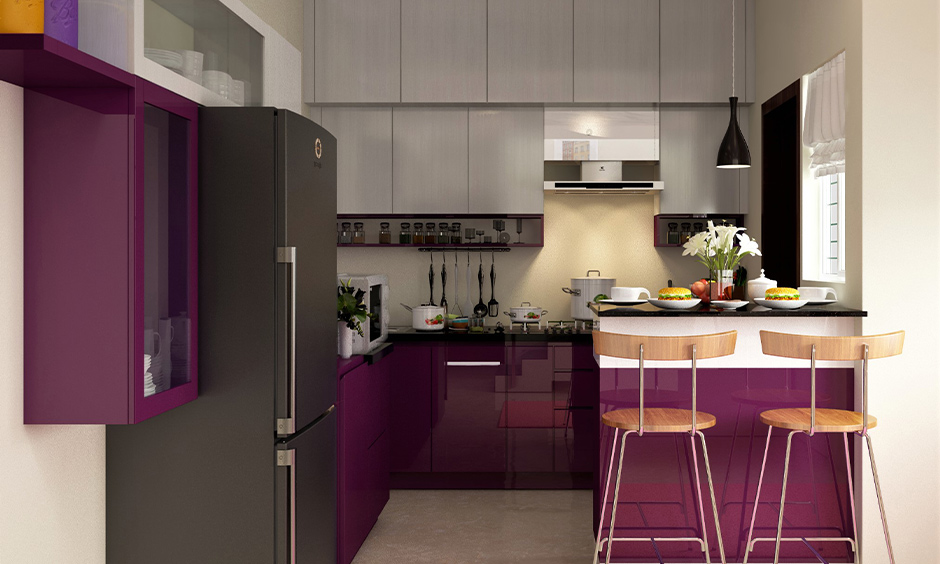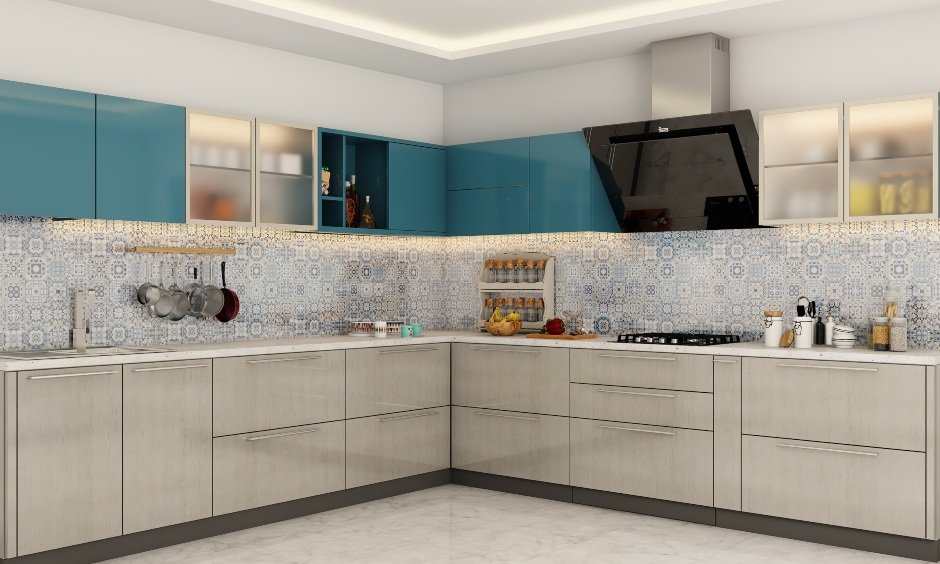If you’re looking for a modular kitchen design that’s a harmonious blend of aesthetics and utility, then opting for PVC kitchen cabinets will be your best bet. Check out why?
Cabinets form an important part of any modular kitchen (ready-made kitchen) owing to its standardised modules or units. They need to be equipped well enough to handle the storage of daily kitchen essentials and appliances. In this context, modular kitchen PVC cabinets have been in trend for quite some time and we’re sure it’s going to stay here for a long while. They’re pocket-friendly and super easy to maintain, a combo that every homeowner ideally wishes for!
What Is PVC Material?
PVC (polyvinyl chloride) is a widely produced polymer or synthetic resin made from the polymerisation of vinyl chloride. It’s a sheet made of plastic composite that’s extremely durable in its purest form. The first thing that comes to mind when PVC is mentioned is pipes and plumbing material. However, PVC is also an extremely versatile material, one that is used for flooring, cabinets, countertops and more.

The complete PVC modular kitchen costs between Rs.20000-Rs.50000 on an average while just the PVC kitchen cabinets cost Rs.200-Rs.350 per square feet. (varies based on material, colour, thickness and designs, etc). If you’re specifically concerned about the price of PVC boards for the kitchen, foam boards start from Rs. 30 per square feet and hollow boards are priced from Rs. 25 per square feet.
Here is a quick overview of the most common PVC modular kitchen designs available in the market today.
- Straight Line – It’s a one-wall kitchen design where the washing area, gas chimney and other kitchen appliances can be accommodated. The storage is well-planned and decided at a micro-level.
- L-Shaped – It’s a popular kitchen design where the corner fittings are placed carefully and optimally utilised. It gives you ample storage area and a good amount of working space as well.
- Island – It’s the most luxurious kitchen design wherein an island is separately installed in the middle of the kitchen irrespective of the type you choose. It provides you with storage over and above what’s already available in existing kitchen wall cabinets. However, it depends upon the overall size of your kitchen.
- U-Shaped – It’s the most optimum kitchen design wherein you get three counters to work on at each side. You can have a separate space for cooking, storage and chopping/washing tasks.
- Peninsula – It’s an open kitchen design wherein the living /dining area is separated from the kitchen by a divider. Choose your fittings and decoration carefully since it will all be visible to the naked eye.
- Parallel – It’s a kitchen design wherein two different counters (ideally one for cooking/appliances and other for chopping/washing) are placed parallel to each other.
Let’s know more about this popular kitchen cabinet material, the types available, how PVC material fares against other kitchen cabinet materials, its pros and cons so that you’re able to make a wise choice for your dream modular kitchen.


Types Of PVC Boards
PVC boards are currently of two kinds – hollow boards and foam boards. Hollow boards are flexible and hollow from the inside, while foam boards are rigid and thicker/broader in nature. Their major advantages and disadvantages are:
- Foam Board – Sturdier | Fire-Resistant | Non-Toxic | Termite-Resistant | Insulated Against Heat | More Hygienic | Corrosion-Resistant | Comparatively Expensive | More Reliable | More Durable | Requires Surface Finishing | Moisture-Resistant | Requires a Bit of Surface Finishing | Requires Highly Skilled Carpenters | Less Shiny
- Hollow Board – Economical | Lightweight | Not Thermal Resistant | Not Termite-Resistant | Not Fire Resistant | Less Sturdy | Less Reliable | Less Durable | Can Be Quickly Installed On-Site | Does Not Require Surface Finishing | Not Moisture-Resistant | Shinier

Both foam PVC kitchen cabinets and hollow PVC kitchen cabinets are great choices as they’re available in a variety of bright colours to instantly jazz up your kitchen’s look. PVC foam boards are also available in glossy, laminate and matt finishes. However, we suggest that you opt for the laminate finish if you get easily bugged by scratches.
Coming to the size and thickness, kitchen cabinets are generally made up of 12 mm-18 mm boards. In the case of foam boards, the thickness lies in the range of 1 mm-30 mm and sheet sizes in the range of 1200 mm x 2400mm. On the other hand, hollow boards are available in 2400mm x 1200mm sizes and with a thickness between 2 mm-35 mm.

Modern Modular Kitchen Designs
How Does PVC Material Fare Against Other Kitchen Cabinet Materials?
When it comes to researching for the perfect modular kitchen cabinet material, the choices are aplenty. Speaking in context, let’s briefly weigh PVC against the solid wood, aluminium, laminate, metal and acrylic (one by one):
PVC kitchen cabinets look minimalist and are easily replaceable. They’re super easy to clean too. As a downside, they’re prone to discolouration after it’s been used for a few years. Notice that yellowish or faded tinge! You will also have to be very careful when selecting hinges and fittings as they need to be compatible with the PVC plastic, else it’ll result in irreversible deformity or damage. We know you don’t want that!
PVC Versus Wood
PVC foam boards are increasingly replacing wooden kitchen cabinets nowadays. They’re cheaper as compared to wooden cabinets and easier to source for replacements. In terms of the holding power, polishing and durability, wooden cabinets score higher points. Solid wood is more expensive, difficult to install, prone to humidity and is not easily replaceable. In terms of the colours, patterns and grains, wooden boards have more variety as compared to PVC boards. Want something that’s in between the two? Try plywood laminates.

PVC Versus Acrylic
Acrylic is another popular material for building modular kitchen cabinets since it’s super glossy and helps the kitchen look bigger as compared to PVC. However, acrylic edges are very fragile and require regular cleaning. It’s slightly more expensive than PVC.
PVC Versus Laminate
Laminates come in more natural textures that simulate the feel of wood or stone that is not the case in PVC. They’re cost-effective and can withstand wear and tear better than PVC. They also come in a lot of different varieties so it’s on par with PVC.

PVC Versus Aluminium
Aluminium is more versatile and expensive as compared to PVC. Aluminium is suitable for all climates and is highly durable. It also offers ease of handling. However, PVC is less noisy than aluminium.
PVC Versus Metal
Metal kitchen cabinets are stronger than PVC kitchen cabinets without any doubt. They’re unaffected by heat and humidity, and easier to clean thanks to its smoother surface. However, the low down of metal is that it’s available in a limited range of colours and needs repolishing when the top surface rusts. Kitchen cabinets made of Metal are noisier than those of PVC.
Hope we were able to help you with this quick guide on all you need to know about PVC as a preferable kitchen cabinet material. So, go ahead and choose PVC kitchen cabinets to your liking to give your kitchen space a more contemporary look.
Explore, More About



















